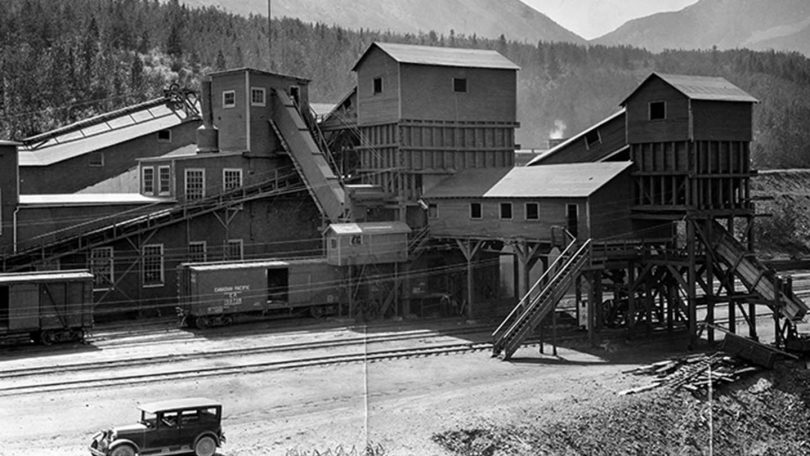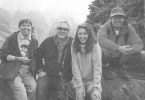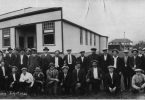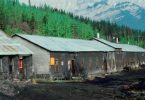If not for coal discovered along Canmore Creek in 1884, Canmore might have had a short life.
The Canadian Pacific Railway founded Canmore in 1883 as a depot to refuel, store, and maintain its locomotives. Yet, only fifteen years later, in 1898, the development of more efficient locomotives led CPR to close its depot, as it no longer needed a roundhouse between Calgary and Field. Thankfully, by that time, the No. 1 Mine was in operation and Canmore’s relationship with CPR as its sole provider of coal for the western region was firmly in place.
Nevertheless, from the time the Canadian Anthracite Coal Co. opened the No. 1 Mine in 1887 and finally secured a contract with CPR in late 1891 or early 1892, Canmore’s survival as a coal-mining town was tenuous, even with its high-quality coal.
The coal extracted from the No. 1 Mine was semi-anthracite coal, hard, lustrous coal that burns hot with little smoke, making it ideal for steam generation. The No. 1 Mine offered much promise as the only location in Canada that could provide anthracite coal. Nevertheless, it also faced challenges, given the distance to available markets and the fact that mining coal in the Rocky Mountains where the thrust-fault action of mountain building bent and broke the coal seams came with increased production costs.
CPR expressed interest in Canmore’s coal as early as 1887; however, it was reluctant to sign a contract until the H.W. McNeill Co. could resolve some additional problems.
In September 1887, William Cornelius Van Horne (then CPR’s vice president and later its president) wrote to McLeod Stewart of the Canadian Anthracite Coal Co. to say CPR was willing to buy Canmore coal but only if the mine could meet certain conditions.
“While I said that we were not willing to contract for any specific amount of coal I did say, that assuming the quality and price to be reasonable and the coal to be properly sized, we would use your coal exclusively in place of the Eastern Anthracite on the Western section of the Railway,” wrote Van Horne.
Even so, the Canadian Anthracite Coal Co. could not meet the railway’s expectations at that time, so without much income, the directors opted in 1888 to sell the mine.
A deal with Hobart W. McNeill, a prominent Seattle lawyer, who had ties to coal companies in Iowa, fell through when he declared bankruptcy. Undaunted, McNeill instead leased the Canmore mine. Soon, McNeill, who was also Van Horne’s friend, overcame the challenges by investing in the mine and negotiating a reasonable freight rate with the railway.
Canmore also got an unexpected boost when Charles Carey, a Canmore-based locomotive engineer, discovered that he could burn the semi-anthracite coal in a locomotive by modifying its firebox grates. He promptly set a locomotive speed record; a feat he later repeated with Van Horne present. Carey’s achievement, along with CPR’s positive evaluation of the quality of Canmore coal in late 1891 and McNeill’s work to eliminate the challenges the mine faced, led the railway to sign a contract to buy annually three-quarters of the coal mined at Canmore.
Van Horne, meanwhile, impressed by the quality of Canmore coal and Carey’s innovation, commented, “A locomotive driver or fireman who cannot use Canmore coal will get no employment with the CPR”.
By 1911, increasingly dissatisfied with how the H.W. McNeill Co. was operating the mines, the Canadian Anthracite Coal Co. passed the contract to the Canmore Coal Company, owned by Americans Samuel Brinkerhoff Thorne and James B. Neale.
Even though the H.W. McNeill Co. was no longer operating the mines, it brought on CPR as a customer and built the curling and skating rinks (the first covered rinks in Alberta) and the Canmore Opera House. The H.W. McNeill Co. also undertook the development of the No. 2 Mine, which would not close until 1963.
The Canmore Coal Co. took over operation of the No. 1 Mine (closing it as planned in 1916), the No. 2 Mine, and the Rundle Mountain Trading Co.
Like McNeill, Thorne and Neale, who profited handsomely from operating the Canmore mines, believed the community should benefit from the mines. During the tenure of the Canmore Coal Co., which ended in 1938, the company built a hall for First World War veterans, the Directors’ Cabin along the Bow River, the Model School and company housing in South Canmore, and a hospital, which led to the naming of Hospital Hill. The Canmore Coal Co. also installed electricity in buildings on Mineside and later Townside. Finally, the Canmore Coal Co. built the briquette plant that manufactured Canmore’s famous pillow-shaped briquettes billed as “the ideal household fuel”.
The Canmore Coal Co. also took Canmore through the First World War, which was good for business. By 1916, miners—some of whom were Ukrainian prisoners from the Banff internment camp—were extracting some 1,100 tons of coal every day. Business continued to be good following the war as growing demand for Canmore coal led the mines in 1929 to reach a peacetime record of 271,000 tons mined with most of it going to CPR.
The good times, of course, ended with the Great Depression. Sales to CPR dropped from that 1929 record to a low of 100,000 tons a year. Miners saw their working days cut from their six-day workweeks to about ten days a month.
The Canadian Anthracite Coal Co. renewed the Canmore Coal Co.’s contract in 1936 for 25 years, but by 1938 Archibald Stewart, a CACC director, had grown increasingly frustrated with the arrangement. He believed the CACC should be operating the mines and reaping the benefits. Stewart pushed through a proposal to buy out the Canmore Coal Co. and form a subsidiary—Canmore Mines Ltd.—to run Canmore’s mines.
Instead of cutting costs toward the end of the Great Depression, Canmore Mines Ltd. initiated a program of improvements and enhancements that included opening the No. 4 Mine.
With the start of the Second World War in 1939, Canmore quickly positioned itself to take advantage of the increased need for coal, and by 1944, yearly sales had reached over 340,000 tons, while the sale of briquettes had hit 100,000 tons.
The war also benefited Canmore miners, at least after coal miners across Western Canada—frustrated at the long hours the government required them to work—began striking. The agreements that followed gave miners a raise and two weeks of paid vacation. In Canmore, miners saw a second raise following another strike in 1946. Canmore Mines Ltd. also agreed to reduce the workweek to five days and put three cents per ton into a miners’ relief fund.
The end of the Second World War, however, brought another downturn with the discovery of oil and gas at Leduc, Redwater and Pembina. With a ready supply of oil, CPR began to switch to diesel locomotives, and by 1955, miners were working two to three days a week. CPR stopped buying Canmore coal altogether in 1960 after it had switched to diesel locomotives.
As it did during the Great Depression, Canmore Mines Ltd. had not been idle. As CPR’s orders decreased, Canmore Mines moved to take advantage of a new market: the Japanese steel and chemical industries. By 1957, Japan had ordered 400,000 tons of coal a year.
Canmore also began to produce coke, selling it to American iron ore smelters after Canmore-born mine engineer and general manager Walter Riva designed a high-temperature coking plant in 1962.
In 1967, Canmore negotiated a $50 million deal with its Japanese customers for 500,000 tons of coal a year; however, Canmore was only producing 300,000 tons a year. Canmore Mines Ltd. used strip mines (Quarry Lake and the Nordic Centre) to bump production by 350,000 tons over seven years, but it was not enough.
The only way Canmore Mines could fulfill its contract was to open a new mine, something that held no interest for the directors; instead, they decided to sell.
The Dillingham Corp. of Hawaii bought the mines in 1971. Four years later, the 1975 Organization of the Petroleum Exporting Countries (OPEC) oil embargo served the final blow.
A sharp increase in shipping costs made it practically impossible to move coal and to open new markets. At the same time, Canmore faced competition from Australia, new Canadian environmental regulations, and demands from existing Japanese customers for a lower price. Dillingham lost $3 million between 1977 and 1979.
At first, Dillingham considered selling the mines; however, by the summer of 1979, the company instead decided to close the mines altogether. On July 9, mine supervisors attended a meeting at the Union Hall where they learned that the mines would close on Friday, July 13: a day known as Black Friday.
Today, the Canmore Miners’ Day, held each July, marks the closing of the mines and honours Canmore’s coal mining heritage.
Submitted by Rob Alexander, 2021
Explore Canmore's Mining Heritage








